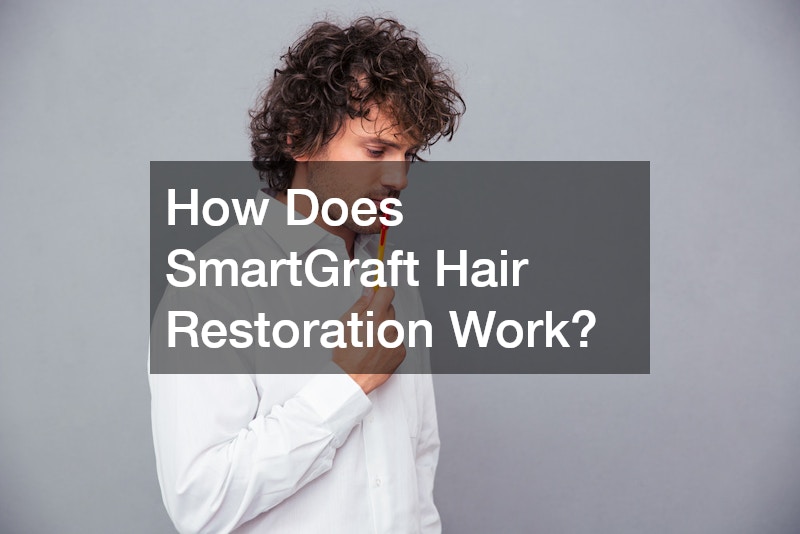
In recent years, advancements in medical technology have revolutionized the way we approach hair restoration. From topical treatments to transplant procedures, the options for those experiencing hair loss are more varied and effective than ever before. Among these solutions, SmartGraft hair restoration stands out as a cutting-edge technique transforming the realm of hair transplants.
Before delving into how SmartGraft works, it’s important to understand the concerns hair loss can create for individuals. Hair has always been a significant part of personal identity, playing a crucial role in how we perceive ourselves and how we are perceived by others.
For many, hair restoration is not just about aesthetics but also about regaining confidence and self-esteem lost to thinning hair or baldness.
Over time, numerous factors such as genetics, age, and lifestyle can contribute to hair loss. While some might embrace baldness, others seek solutions to restore their hairline and thicken their locks. Fortunately, innovative methods like SmartGraft offer promising results for those desiring natural-looking hair restoration without invasive surgical procedures.
The SmartGraft Technology
SmartGraft hair restoration distinguishes itself through its emphasis on minimally invasive procedures and advanced technology. Unlike traditional hair transplant methods, it employs a cutting-edge device that allows for precise extraction and transplant of hair follicles. This technique is based on Follicular Unit Extraction (FUE), which is renowned for its natural results and minimal scarring.
The SmartGraft device simplifies the process by automating many of the manual labor aspects typically involved in hair transplant surgeries. It uses a pneumatic system to gently remove individual hair follicles, ensuring the preservation of their integrity. By maintaining the health of the hair follicles during the extraction process, SmartGraft increases the likelihood of successful regrowth in the treated area.
Another significant benefit of the SmartGraft system is its efficiency and reduced procedure time. Patients often enjoy shorter recovery periods compared to traditional methods, getting back to their daily activities sooner. This streamlined approach not only provides convenience but also supports better consistency in transplantation outcomes.
Steps Involved in SmartGraft Hair Restoration
The process of SmartGraft hair restoration involves meticulous planning and execution to achieve optimal results. It begins with a comprehensive consultation where the patient’s hair loss pattern, donor site availability, and overall desired outcomes are evaluated. Based on this evaluation, a personalized treatment plan is devised to address specific needs and concerns.
The second step entails the extraction of hair follicles from a designated donor site, typically the back of the scalp. Using the SmartGraft device, the hair follicles are carefully harvested without causing significant damage to the surrounding tissue. This precision is critical to the success of the procedure, ensuring that the harvested follicles produce healthy, natural-looking hair in their new location.
Once harvested, the follicles are stored and nurtured in a temperature-controlled container, preserving their viability before transplantation. The final step involves the meticulous implantation of these grafts into the thinning or balding areas. The aim is to mimic the natural growth pattern, ensuring the newly transplanted hair blends seamlessly with existing hair.
Benefits of SmartGraft Hair Restoration
SmartGraft hair restoration provides a multitude of benefits over other hair transplant methods. One of its standout features is the ability to achieve a fuller, natural-looking head of hair with minimal downtime. The minimally invasive nature of the procedure results in less discomfort and quicker recovery, allowing patients to return to their normal activities in no time.
Furthermore, the precision of SmartGraft allows for the extraction and placement of high-quality grafts that maximize the success of hair regrowth. By ensuring the follicles are healthy and intact, it significantly reduces the risk of graft failure. This improvement in graft quality translates to higher patient satisfaction and more reliable outcomes.
Another advantage is that SmartGraft results in minimal scarring compared to traditional strip methods. This is particularly beneficial for individuals who prefer to wear their hair short, as it preserves the natural appearance of the donor area. As a result, SmartGraft provides an effective hair restoration solution that enhances aesthetic appeal without compromising the donor site.
Conclusion
SmartGraft hair restoration represents a leap forward in the field of hair transplants, combining advanced technology with minimally invasive techniques. For those seeking a reliable solution to hair loss, SmartGraft offers a path to regaining not just hair, but also personal confidence and a sense of identity. Its advantages over traditional methods make it an appealing choice for individuals looking to enhance their appearance with natural-looking results.
The detailed process of SmartGraft ensures personalized treatment tailored to the unique needs of each patient. By focusing on the health and integrity of hair follicles, it ensures long-lasting and aesthetically pleasing outcomes. As innovation continues to drive the field of hair restoration, SmartGraft remains at the forefront, offering hope to many dealing with the challenges of hair loss.
For anyone considering this procedure, consulting with a qualified professional is the first step towards a successful hair restoration journey. Understanding the specifics of SmartGraft and its benefits can empower individuals to make informed decisions about their hair care. Ultimately, SmartGraft not only provides a solution to hair loss but also helps restore the confidence that comes with a full head of hair.
.




